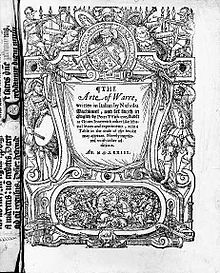The Art of War (Machiavelli)

About the Art of War or Dell'arte della guerra by Niccolò Machiavelli , written between 1519 and 1520, is a treatise on tactics , strategy , politics and mainly the military .
In contrast to works like Der Fürst or the Discorsi , the art of war is one of the lesser-read works of the well-known statesman and philosopher of the Renaissance. Machiavelli himself considered it his most important work.
content
The art of war arose at a time when Italy was marked by war, intrigue and foreign occupiers. Machiavelli attributed this situation mainly to errors of political and military leadership.
The Arte can be divided into two halves with different content: a military-tactical treatise and a political one.
In the first, he describes, among other things, the various options for using the army in times of war and peace. For example, he believes that an army can be used as a means of conquest, protection, calming, and support for the prince and the law.
In a dialogue between Machiavelli's friends, he has the condottiere Fabrizio Colonna report on the decline of Italian virtues , especially in the ranks of the princes. Machiavelli gives numerous reasons why imitation of Roman customs, military discipline, tactics and strategy would be beneficial for Renaissance Italy.
A peculiarity in war literature is the fictitious battle in which one of Machiavelli's friends successively defeats the enemy with an army that has been prepared down to the last detail. The ensuing discussion is of considerable importance for the tactics of the time. Although critics kept saying that Machiavelli's proposals, especially the imitation of ancient Roman tactics, were obsolete in the age of the emerging firearms and artillery , they served as inspiration to military leaders like Moritz of Orange and Gustavus Adolf of Sweden .
Machiavelli also discusses methods used by princes and military commanders to motivate and train soldiers. The problem of excavation is also discussed.
Similar to his other works, he adopts many ideas from ancient authors of the genre. Well-known war philosophers such as Polybios , Frontinus and Vegetius play a major role.
The political ideas of the second half of the book are broadly similar to those of the Discorsi and the Prince .
Despite having the same title, Arte della Guerra differs fundamentally from Sunzi's well-known work The Art of War .
expenditure
- The art of war in seven books together with small military writings by Niccolo Machiavelli. Translated from the Italian by Johann Ziegler (= Niccolo Machiavelli's Complete Works. Vol. 3). Groos, Karlsruhe 1833, pp. 1–192 (digitized version ) .
This translation has been reissued as part of a current complete edition of Machiavelli's works:
- The Art of War (Dell'arte della guerra). In: Alexander Ulfig (ed.): Collected works. From the State, From the Prince, History of Florence, The Art of War, Little Scripts, Comedies, Dialogue on Language, The Belfagor Novella. Zweiausendeins, 2nd edition 2006, ISBN 3-86150-774-9 / Dörfler, Eggolsheim 2011, ISBN 3-89555-702-1 , pp. 709-856.
literature
- Volker Reinhardt : Machiavelli or the art of power. A biography. Beck, Munich 2012, ISBN 978-3-406-63017-0 , pp. 324-331 .
